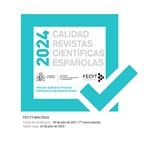¿Qué debía entenderse por “Música Negra” en la censura franquista? Un estudio sobre la circular 146 (1943). (RI §422718)

What did francoist censorship understand by “Black music"? A study of circular 146 (1943) -
Fernando Centenera Sánchez-Seco
En 1942 la Vicesecretaría de Educación Popular prohibió la emisión de “música negra” en la radio. Sin embargo, probablemente no se tuvo en cuenta que aquella expresión sería fuente de incertidumbres: ¿qué debía entenderse por tal a la hora de aplicar la censura? Este estudio considera los intentos de aclaración que recogería el año siguiente la Circular 146, en términos de prohibición y permisión. Los desarrollos que se presentan tratan de establecer los motivos que condujeron a plantear los puntos de aquel texto, y analizan numerosos problemas que suscitan estos últimos en las parcelas de la lingüística e interpretación normativa. Finalmente, se plantean algunas reflexiones en torno a las deficiencias formales constatadas y la justicia.
I. INTRODUCCIÓN, II. LA POLÍTICA MUSICAL DE LA DICTADURA, III. LA CIRCULAR 146: ORIGEN Y PLANTEAMIENTO, IV. CRITERIOS PARA LLEVAR A CABO LA PROHIBICIÓN, 1. Las ‘pretendidas’ aclaraciones, 1. 1. El jazz antimusical, estridente y con “ritmo desenfrenado”, 1. 2. El “fox y otras danzas exóticas”, 1. 3. Los tipos de jazz (¿o sobre la melodía y el ritmo?) y las causas del efecto deformador, 2. El recurso al “buen gusto”: ¿la solución a los problemas de interpretación?, V. LA MÚSICA PERMITIDA, 1. Ejemplos de composiciones sinfónicas, 2. Rumbas, sones, danzas cubanas, música criolla y típica de ‘hispanoamérica’, 3. Ópera y música intrascendente para las colonias, VI. EL CRITERIO “PERSONAL Y ARTÍSTICO” Y EL APEGO A LAS NORMAS, 1. Un análisis desde las concepciones del Derecho, 2. Las consecuencias, VII. LAS AFECTACIONES DE LOS FRACASOS CONSTATADOS EN LA JUSTICIA, VIII. GLOSARIO DE TÉRMINOS MUSICALES ESPECÍFICOS, IX. FUENTES, 1. Bibliografía, 2. Catálogo de discos, 3. Diccionarios y enciclopedias, 4. Documentos de archivo, 5. Hemeroteca, 6. Normativa publicada, 7. Recursos sonoros.
In 1942, the Under-Secretary for Popular Education banned the playing of “black music” on the radio. In all likelihood, no one realised that the expression “black music” would give rise to all sorts of uncertainty: what should it be taken to mean when censoring? This study analyses the attempts made by the following year’s Circular 146 to clarify the issue in terms of prohibition and permission. In the process, it seeks to discover the reasons behind the circular’s various points and to consider a number of problem those points raise regarding linguistics and regulatory interpretation. It concludes with some reflections on the formal deficiencies found and on justice.
I. INTRODUCTION, II. MUSICAL POLICY IN THE DICTATORSHIP, III. CIRCULAR 146: ORIGIN AND RATIONALE, IV. THE GROUNDS FOR BANNING, 1. The “purported” clarifications, 1. 1. Jazz: anti-music, loud and “frenzied rhythm”, 1. 2. The “fox and other exotic dances”, 1. 3. Types of jazz (or, on melody and rhythm?) and how it deforms, 2. The appeal to “good taste”: the solution to problems of interpretation?, V. APPROVED MUSIC, 1. Examples of symphonic compositions, 2. Rumba, sones, Cuban dances, Creole and other typically “Hispanoamerican” music’, 3. Opera and music of little consequence for the colonies, VI. THE “PERSONAL AND ARTISTIC” BENCHMARK AND ABIDING BY THE RULES, 1. An analysis from the legal standpoint, 2. The consequences, VII. THE FALL-OUT FROM DOCUMENTED LEGAL FAILURES, VIII. GLOSSARY OF MUSICAL TERMS, IX. SOURCES, 1. Bibliography, 2. Catalogue of recordings, 3. Dictionaries and encyclopedias, 4. Archival sources, 5. Periodicals, 6. Published legislation, 7. Audio resources.

 DIRECTORA
DIRECTORA